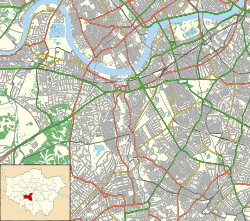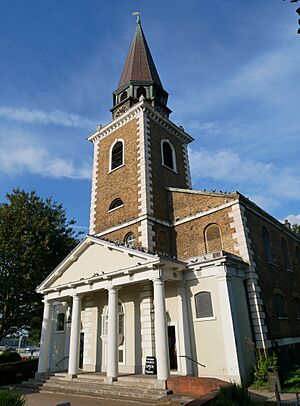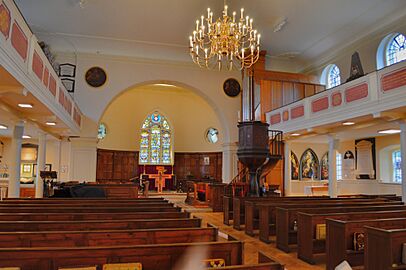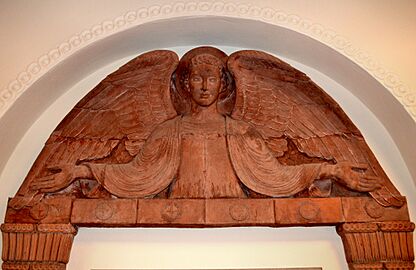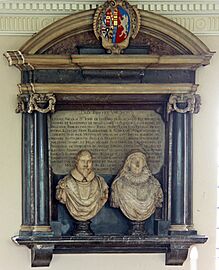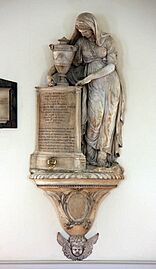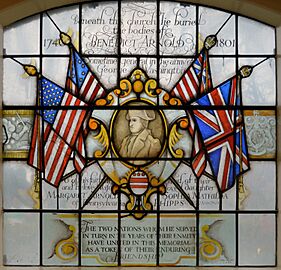St Mary's Church, Battersea facts for kids
Quick facts for kids St Mary's Church, Battersea |
|
|---|---|
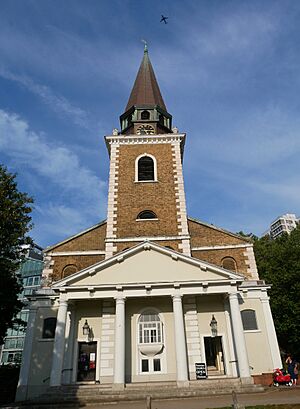
West face of the church
|
|
| 51°28′36″N 0°10′32″W / 51.47657°N 0.17544°W | |
| Location | Battersea Church Road, Battersea, Greater London, SW11 3NA |
| Country | England |
| Denomination | Church of England |
| Churchmanship | Inclusive Central |
| History | |
| Status | Active |
| Founded | c.800 AD |
| Architecture | |
| Functional status | Parish church |
| Heritage designation | Grade I listed |
| Completed | 1777 |
| Administration | |
| Diocese | Diocese of Southwark |
St Mary's Church, Battersea is an Anglican church in Greater London. It is the oldest church in Battersea, a part of the London Borough of Wandsworth. This church is special because Christians have worshipped here continuously since around 800 AD. It is also a Grade I listed building, which means it's very important for its history and amazing design.
Contents
A Look at St Mary's Church History
St Mary's is one of the very first Christian places south of the River Thames in London. The first church was built here around 800 AD. The building you see today was finished in 1777. It was designed by a local architect named Joseph Dixon.
The church is mostly built from brick, with stone used for special decorative parts. It has a main hall called a nave, a rounded area at the east end called an apse, and a tall tower at the west end. The front entrance has a porch with columns and a triangular top. The tower behind it has a clock and a small spire.
Inside, the church has a flat ceiling that covers the whole width. There are wooden balconies, called galleries, on three sides, held up by columns. The windows in the main hall are in two rows, with the top ones having rounded tops.
Art and Music Inside the Church
In a side chapel, there's a modern artwork called a triptych by John Napper (made in 1946). It shows a famous Bible scene, the Annunciation, but with Battersea Park and the Power Station in the background! Another part shows Jesus walking on the Thames River, and another shows Lazarus rising from the dead near the church porch.
The church organ was made by Saxon Aldred in 1993. It has a cool carving of a ram, which is a nod to the nearby Ram Brewery.
In the special area called the sanctuary, the east window is very old, from 1379. Some painted glass in this window is from 1631 and shows portraits of King Henry VII, Margaret Beaufort, and Queen Elizabeth I. Other windows, called the Dove and Lamb windows, were first made in 1796 by James Pearson. They were fixed in 1946 after being damaged during World War II.
At the back of the church, there's a special War Memorial made of terracotta by Freda Skinner. It shows the "Gate of Life" guarded by an "Angel of Sacrifice."
The glass doors leading to the Vestry were added in 2008 and were beautifully engraved by Sally Scott FGE.
Famous Connections
St Mary's Church has strong links to art and writing. The famous artist and poet William Blake got married here to Catherine Boucher on August 17, 1782. Also, the well-known painter J. M. W. Turner used to paint the river from the vestry window.
The church has even been used as a filming location! It appeared in the ITV drama Soldier Soldier for a funeral scene in 1994.
Special Stained Glass Windows
The church has four newer stained glass windows made by John Hayward between 1976 and 1982. Each one tells a unique story.
The Blake Window
This window honors William Blake. It shows a figure called Albion at the bottom. In the middle, there's a winged figure called 'Emanation'. A portrait of Blake from a painting by Thomas Phillips is also included. Figures on either side represent "Innocence" and "Experience," which were themes in Blake's work. At the bottom left, you can see Blake's signature from the church's marriage register, along with two drawings by him and his wife, Catherine.
The Turner Window
This window is dedicated to J. M. W. Turner. Turner lived nearby and often visited Battersea to paint from the church's vestry window. This window was given by The Morgan Crucible Company Ltd to remember their long connection with Battersea.
The Curtis Window
This window remembers William Curtis, a botanist (someone who studies plants) and the founder of the Linnean Society. He is buried in the churchyard. The window's frame shows many plants from his book 'Flora Londinensis', like geraniums, wild daffodils, and primroses. It also includes symbols from important plant societies and a map showing where his gardens were located.
The Arnold Window
This window features a portrait of Benedict Arnold in his military uniform. Below him are the arms of George Washington and different versions of the American flag, including the Betsy Ross flag and the Continental Union flag from 1775. The Union Jack flag is also shown. Benedict Arnold fought for Washington in the American War of Independence, but later changed sides and became an officer in the British Army.
Important Monuments and Memorials
St Mary's Church has several important monuments from its earlier days. These are like special sculptures or plaques that remember important people.
- Baron Oliver Nicholas St John of Lydeard (died 1630) and his wife, Joan Roydon. He was a very important person in Ireland. Their monuments include busts (sculptures of their heads and shoulders) made by Nicholas Stone the Elder.
- Sir Edward Wynter (died 1685). His monument has a bust at the top. The bottom part shows him fighting a tiger and Moors, and the writing tells about his exciting adventures.
- Sir John Fleet (died 1712). He was the Lord Mayor of London in 1695.
- James Bull (died 1713). He was a merchant and Sir John Fleet's son-in-law.
- Henry St John (died 1751), Viscount Bolingbroke, and his wife, Mary Clara des Champs de Marcilly (died 1750). He was an important government official. Their monument has small portraits of them facing each other. The sculptor was Louis-François Roubiliac.
- John Camden (died 1780) and his daughter Elizabeth Neild (died 1791). Their monument shows a girl next to a funeral urn, with a poem. It was made by Coade of Lambeth in 1792.
- Richard Rothwell (died 1821) and his wife Eleanor (died 1834). This monument was made by J. G. Bubb.
Famous People Buried Here
Many notable people are buried at St Mary's Church.
- Benedict Arnold and his family are buried in the crypt (an underground room).
- William Curtis, the botanist, is buried in the churchyard.
- John Inglis (bishop)
- Sir Rupert George
- Nathaniel Middleton (1750–1807), who worked for the British East India Company.
Gallery


